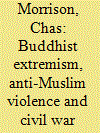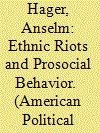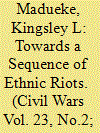| Srl | Item |
| 1 |
ID:
174799


|
|
|
|
|
| Summary/Abstract |
A post-civil war country may cease military activity, but the social rupture impacts political discourse and ethnic relations, and can lead to collective violence against minorities. Sri Lanka has witnessed multiple examples of anti-Muslim sentiment and violence since the civil war termination, most infamously in 2014 when ethnic riots affected large numbers of people. Buddhist monks appeared to play a prominent role. The lengthy war and ethnonationalist ideologies have produced politico-religious shifts associated with ‘Buddhist extremism’, implicated in these riots and other aggressions. This paper uses interview data to explore the question: what causal mechanisms link post-civil war and extremist ideologies, and how this can lead to ethnic rioting. Interview respondents argue that promoting a monolithic national identity in a heterogeneous country enhances divisions, which can be politically expedient. An outright war victory, militarization of society and lack of peacebuilding sustain ethnic tensions that can be mobilized for further anti-minority violence.
|
|
|
|
|
|
|
|
|
|
|
|
|
|
|
|
| 2 |
ID:
168537


|
|
|
|
|
| Summary/Abstract |
Do ethnic riots affect prosocial behavior? A common view among scholars of ethnic violence is that riots increase cooperation within the warring groups, while cooperation across groups is reduced. We revisit this hypothesis by studying the aftermath of the 2010 Osh riot in Kyrgyzstan, which saw Kyrgyz from outside the city kill over 400 Uzbeks. We implement a representative survey, which includes unobtrusive experimental measures of prosocial behavior. Our causal identification strategy exploits variation in the distance of neighborhoods to armored military vehicles, which were instrumental in orchestrating the riot. We find that victimized neighborhoods show substantially lower levels of prosocial behavior. Importantly, we demonstrate that the reduction is similarly stark both within and across groups. Using qualitative interviews, we parse out two mechanisms that help explain the surprising reduction in ingroup prosociality: Victimized Uzbeks felt abandoned by their coethnics, and variation in victimization created a feeling of suspicion.
|
|
|
|
|
|
|
|
|
|
|
|
|
|
|
|
| 3 |
ID:
119042


|
|
|
|
|
| Publication |
2012.
|
| Summary/Abstract |
One distinguishing feature of mainstream social science is its growing regard for model building and formal hypothesis testing. In South Asian studies this is most evident in accounts of ethnic riots or communal violence. This paper examines a model of votes and violence proposed by Steven Wilkinson. We first examine how well the model performs against a data set that we have assembled on the twenty worst incidents of communal violence in India since 1950. The Wilkinson model is consistent with some important key facts in our data set, most notably in terms of levels of urbanization and "percentage Muslims" in riot-affected towns and cities. However, proximity to national or state elections is not found to be a strong driver of prolonged ethnic rioting. Nor is it the case that India's worst instances of communal violence occurred mainly where there was direct electoral competition between less than 3.5 effective political parties, the other main predictive variable in the Wilkinson model. We then discuss the limitations more broadly of attempts to explain and even predict ethnic violence within the framework of a quantitative model. We pay attention to time inconsistencies, principal-agent problems, religiosity and the homogenization of riot events, and omitted variables (notably, memory work and ideological fervour). We conclude with some general remarks on the search for order in social science.
|
|
|
|
|
|
|
|
|
|
|
|
|
|
|
|
| 4 |
ID:
181099


|
|
|
|
|
| Summary/Abstract |
Ethnic riots are not as unstructured as the literature suggests. There is a clear sequence of events through which violence erupts. This article explains four stages of the build-up to deadly clashes: the triggering incident; the spread of rumours; the emergence of armed mobs; their interaction and the eruption of violence. Drawing on extensive ethnographic fieldwork in Jos, Nigeria, the article identifies the mechanisms that define each stage and argues that they need to happen for mass violence to occur. The conclusion reflects on the findings’ theoretical implications as well as their relevance for violence prevention and peacebuilding.
|
|
|
|
|
|
|
|
|
|
|
|
|
|
|
|